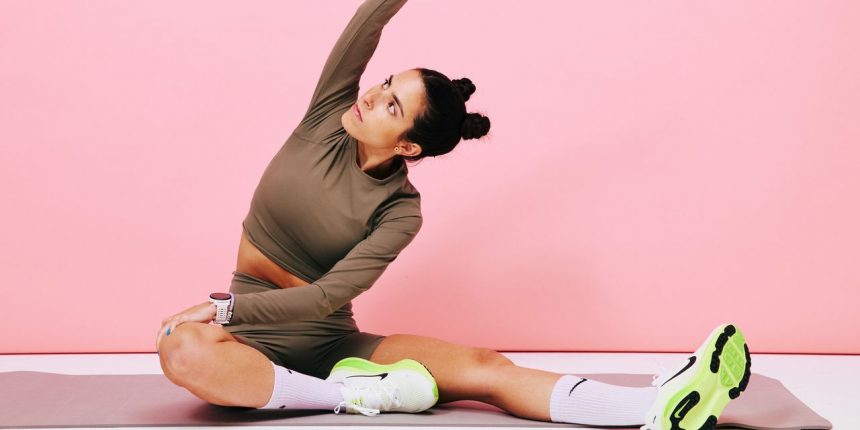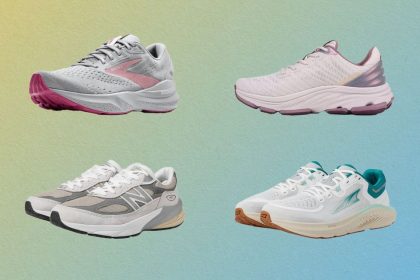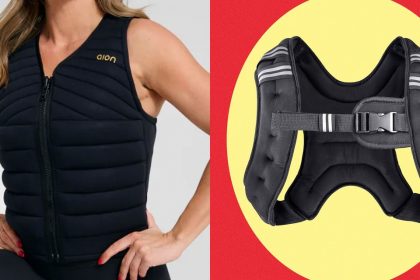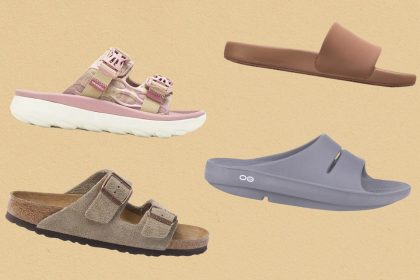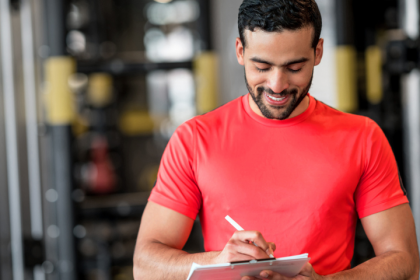Your running program is packed with cardio days and sprinkled with strength routines, but that’s not all—it also includes a lot of sweet, sweet rest. This is vital not only because it feels so damn good, but also because you need those days to recover. After all, that’s when your body adapts to the stresses you’ve placed on it, so you can do it all over again (and even better) the next time.
Sometimes, rest days can—and should—be just that, days with zero exercise at all on your schedule. You can take advantage of the time off to do something else that enhances your well-being, whether that’s catching up with a friend, reading that novel that’s been parked on your nightstand, or getting crafty and creative with a few new projects.
But in other cases, you might want to move a little in ways that feel good for your body and mind. Enter: active recovery, or gentle movement that’s a lot less intense than your typical workout. You might choose to take a (light!) yoga class, go for an easy walk, or spend some quality time with your foam roller.
Another option? A quick active recovery routine. Amanda Katz, an NASM-certified personal trainer and running coach in New York City, designed the ones below as part of SELF’s Learn to Love Running Program to complement the strength and cardio workouts that make up the bulk of your plan. These dynamic routines were created to help link your mind and body, centering you so you’re ready to get back to running, lifting, or whatever other more intense activities are on your docket the next day.
The goal here is to move at a slower pace than the rest of the week, gently boosting blood flow while taking your joints through a wide range of motion to improve mobility. Runners who regularly work on mobility may reduce pain and stiffness while also improving performance, Katz says. These sessions also offer an opportunity to notice—and address—any minor imbalances before they turn into pain or injuries. For example, if your right hip feels tighter than your left one in pigeon pose, you can spend a few extra minutes there for an added release.
Feel free to pick and choose which routine to do on any given day, exploring what feels good for your body. Try a new sequence if you want more variety, repeat the ones you like, or even, once you’ve tried them all the way through a few times, mix and match the exercises that work the best for you. Just a note, though, that they’re organized so that the last two may require slightly more mobility than the first two—keep that in mind as you give them a try.
Set aside 15 to 25 minutes for each routine; the exact duration will depend on how quickly or slowly you perform reps, how much rest you take between rounds, and if your body requests a little more TLC in one particular area!
Active Recovery #1
What you need: A bench, chair, couch, or other sturdy surface, a dumbbell to hold, and an exercise mat for comfort.
Directions
- Do 10 reps of each dynamic exercise. For single-sided moves, do 10 reps on each side. For static stretches, hold for the time given.
- After all your reps are done, move on to the next exercise.
- After all four exercises are completed, rest for up to 2 minutes before starting from the top again.
- Complete the circuit 2–3 times total.
World’s Greatest Stretch
Katie Thompson
- Start in high plank position with your palms flat on the floor, hands shoulder-width apart, shoulders stacked directly above your wrists, legs extended behind you, and your core and glutes engaged.
- Bring your left knee up in a lunge position with your left foot outside your left hand. You should feel a stretch at the front of your right thigh.
- Rotate your upper body to the left as you extend your left arm toward the ceiling.
- Return your hand to the floor, then step back into a plank position. This is 1 rep. Complete 10 reps total on each side, then repeat on the other side.
It’s earned the title for good reason—you’ll open your hips and increase mobility through your thoracic spine, or middle back, with this classic move.
Lateral Adductor Rock
Katie Thompson
- Begin in a kneeling position, holding a dumbbell (or kettlebell, if you’ve got one) in both hands in front of your body at arm’s length.
- Step your left foot out to the side, placing your foot flat on the floor. Point your left toes straight to the left; your left thigh should be perpendicular to your right leg.
- Slowly rock to the left, keeping your hips facing forward, going as low as feels comfortable.
- Return to the starting position. Do 10 reps, then repeat on the other side.
This movement stretches and strengthens the adductor muscles in your inner thighs while improving the range of motion in your hip joints.
Bear Hold to Down Dog
Katie Thompson
- Begin in a tabletop position, knees bent and under your hips, palms flat under your shoulders. Make sure to keep your spine neutral.
- Spread out your fingertips, push into the floor, and lift your knees off the ground into a bear hold. Balance on your toes and keep your heels pointed straight up toward the ceiling.
- From there, continue pushing through your hands as you straighten your legs and shift your hips back into a downward dog position.
- Return to tabletop; that’s 1 rep. (If you need to take a short breather between any of your reps, you can briefly let your knees touch down to the floor.)
- Complete 10 reps.
Moving through this sequence mobilizes everything from your shoulders and middle back to your toes, hitting your calves, quads, and glutes along the way.
Couch Stretch
Katie Thompson
- Stand in front of a couch, chair, or other sturdy surface. You might want a pad, cushion, or folded mat to place under your knee.
- Bend your left knee and hook your left foot on the seat of the couch or chair.
- Take a step forward with your right leg, then lower down until your right knee is directly over your ankle.
- Place your left knee on the pad or cushion and your shin against the couch or chair.
- Engage your core and glutes as you keep your spine long. Hold for 30 seconds to 1 minute.
The couch stretch relieves tightness and improves mobility in your quads, back, core, and hips. Note that it can feel intense—especially if you have knee problems. If it feels too intense, you can sub in the standing quad stretch from your cooldown routine.
Active Recovery #2
What you need: Just an exercise mat for comfort.
Directions
- Do 10 reps of each dynamic exercise. For single-sided moves, do 10 reps on each side. For static stretches, hold for the time given.
- After all your reps are done, move on to the next exercise.
- After all four exercises are completed, rest for up to 2 minutes, before starting from the top again.
- Complete the circuit 2–3 times total.
Seated QL Stretch
Katie Thompson
- Sit with your back straight and your legs wide, then bend your left knee to bring your left foot toward your right inner thigh.
- Use your right hand to grab your left knee, rotating your torso so it’s aligned with your left thigh.
- Reach your left hand high, then tilt your torso to the right, over your straight leg.
- Hold for 30 seconds to 1 minute, then repeat before switching to the other side.
Your quadratus lumborum or QL muscle, deep in your back, runs from the bottom of your rib cage to the top of your pelvis. It plays a role in stabilizing your spine and in breathing, and tightness there often contributes to lower back pain.
Child’s Pose with Thread the Needle
Katie Thompson
- Begin in child’s pose: Kneel on your mat with your knees hip-width apart or wider and your toes touching together behind you. Take a deep breath in, and as you exhale lay your torso over your thighs. Try to lengthen your neck and spine by drawing your ribs away from your tailbone and the crown of your head away from your shoulders.
- On an exhale, lift up slightly and slide your right arm under your body, rotating through your middle back to rest your right shoulder and the right side of your head on the ground.
- Return to center, then repeat on the left side. Do 10 reps on each side.
Child’s pose elongates and aligns your spine, while threading the needle stretches your shoulders and back while adding an element of rotation to ease stiffness through the mid-back.
90/90 with Overhead Reach
Katie Thompson
- Sit with your left knee bent at 90 degrees in front of you, calf perpendicular to your body and the sole of your foot facing to the right. Keep your left foot flexed.
- Let your leg rest flat on the floor.
- Place your right knee to the right of your body, and bend the knee so that your foot faces behind you. Keep your right foot flexed.
- Keep your left butt cheek on the floor. Try to move the right cheek as close to the floor as possible. It may not be possible if you’re super tight.
- Place your left hand on the floor to the side of your left hip. Then raise your right hand and reach overhead with a side bend.
- Return to the starting position. That’s 1 rep. Complete 10 reps, then switch sides and repeat.
This is another combo move that opens your hips while also lengthening and releasing the obliques and other muscles along your side.
Sciatic Nerve Glides
Katie Thompson
- Lie on your back with your knees bent, feet on the floor.
- Grab the back of your right thigh and hold it with both hands.
- Flex your right foot to pull your toes toward your face.
- Gently straighten your right leg, then return to the starting position.
- Complete 10 reps, then repeat on the other side.
The sciatic nerve runs from your butt all the way down each leg; this movement can relieve extra pressure that sometimes compresses it to ease pain and tightness in your lower back and legs.
Active Recovery #3
What you need: A chair or other stable object to hold onto and an exercise mat for comfort.
Directions
- Do 10 reps of each dynamic exercise. For single-sided moves, do 10 reps on each side. For static stretches, hold for the time given.
- After all your reps are done, move on to the next exercise.
- After all four exercises are completed, rest for up to 2 minutes, before starting from the top again.
- Complete the circuit 2–3 times total.
Hip Airplanes
Katie Thompson
- Stand on your left leg, holding a chair or other stable object for balance.
- Slightly bend your left knee, and bend your right leg, lifting it behind you.
- Slowly rotate your hips to the right, keeping your knee aligned with your second toe. You might find it helpful to keep your right hand on your right hip to guide it through the movement. Return to the starting position.
- Do 10 reps then repeat on the other side.
This movement improves hip mobility and control, requiring rotation of the joint while you’re supporting your body weight on one leg.
Half-Kneeling Groin Rockers
Katie Thompson
- Begin in a tabletop position, knees bent and palms flat under your shoulders.
- Stretch your right leg out to the side, resting your right foot on the floor.
- Shift your body back slightly, bending your left knee more deeply as your shoulders move back. You’ll feel a stretch in your right inner thigh.
- Shift back forward to return to the starting position.
- Do 10 reps then repeat on the other side.
Keep your groin and hip muscles mobile and flexible with this small but effective movement.
Thoracic Rotation Stretch
Katie Thompson
- Lie on your right side with your hips and knees bent 90 degrees and your arms outstretched, so your thighs and arms are parallel. Use a pillow, block, or blanket to support your head if it feels more comfortable.
- Lift your left arm and slowly rotate your torso only—keeping your legs in place—until your left wrist and shoulder reach the floor on the other side of your body. Rest the back of your head on the floor or pillow.
- Rotate back to the right to return to the starting position.
- Do 10 reps before repeating on the other side.
You’ll stretch your spine, chest, and shoulders while you strengthen your obliques, the core muscles that run along the sides of your waist.
Side Plank Hip Abduction
Katie Thompson
- Start in a forearm side plank by propping your body up on your right forearm, with your elbow stacked underneath your shoulder and your hand in front of your body. Extend your legs, stacking your left foot on top of your right.
- Raise your left leg straight out and slightly back, flexing your left foot as you do.
- Hold for 30 seconds (if that’s too hard, work your way up from 10 seconds in 5-second increments). Repeat on the other side.
Strengthen your glute medius and other muscles along the side of your hip while you stretch and release the QL muscle, deep in your back.
Active Recovery #4
What you need: A sturdy box, step, or bench, and an exercise mat for comfort.
Directions
- Do 10 reps of each dynamic exercise. For single-sided moves, do 10 reps on each side. For static stretches, hold for the time given.
- After all your reps are done, move on to the next exercise.
- After all four exercises are completed, rest for up to 2 minutes, before starting from the top again.
- Complete the circuit 2–3 times total.
Prone Extension
Katie Thompson
- Lie on your stomach with hands underneath your shoulders, elbows pointing straight behind you, palms flat on the ground, and big toes touching each other. Lightly press your feet into the floor. This is the starting position.
- Inhale, then exhale and pull your belly button in toward your spine.
- Inhale again and press through your palms to lift your chest off the floor. You can stop with a bend in your elbows or push up until your arms are almost, but not quite, straight, as pictured. You should feel a stretch through your chest, the front of your shoulders, and/or the front of your hips. Return to starting position, then repeat.
- Complete 10 reps.
Often called cobra in yoga class, this movement extends your spine and stretches your hip flexors and chest muscles.
Kneeling Cat-Cow
Katie Thompson
- Start in a kneeling position, with your butt resting on your heels and your hands on the floor in front of you.
- Take a slow inhale, and on the exhale, round your spine and drop your head toward the floor (this is the cat posture).
- Inhale and lift your head, chest, and tailbone toward the ceiling as you arch your back for cow. This is 1 rep.
- Complete 10 reps total.
A modified version of an all-time favorite back release, this version keeps your pelvis and lower back stable so you can focus on mobilizing your middle and upper back.
Straight Leg Feet-Elevated Hip Extension
Katie Thompson
- Lie on your back with your feet elevated on a chair, bench, or other stable surface.
- Lift your hips up, squeezing your glutes, while trying not to let your back arch.
- Start by keeping your hands on the ground as pictured; once you’re comfortable with the movement, you can add a challenge by raising your arms.
- Work up to holding for 30 seconds.
As you extend your hips and activate your glutes, you’ll also target the QL, deep in your lower back—it’s tough to reach, but frequently linked to back pain.
Pigeon Pose With Rock
Katie Thompson
- Start in a tabletop position on your hands and knees on a yoga mat.
- Bring your right foot forward and place it down on the mat behind your right wrist.
- Adjust your shin so it’s parallel (or as close to parallel as you can get) to the front edge of your mat.
- Extend your left leg back with the top of your left foot resting on the mat. If needed, elevate the hips and support them with a block, rolled blanket, or bolster.
- Keep your chest up and graze the floor with your fingertips as pictured.
- From this position, gently move your upper body back and forth as pictured to deepen the stretch as pictured. Each back-and-forth movement is 1 rep. For an added quad stretch, bend and straighten the back knee.
- Repeat 10 times before moving on to the other side.
Another one-two punch: The hip-opening power of pigeon pose meets a dynamic quad stretch.
Photography: Katie Thompson. Wardrobe styling: Kathleen Thomas. Hair: Walton Nunez. Makeup: Miranda Richards.
Athletes in order of appearance: Ameerah Omar, city captain and mindset coach for Adidas Runners NYC, wears: Alo sports bra and leggings, Nike socks, and Hoka sneakers; Laura Girard, a NASM-certified personal trainer and founder of The Energy Academy, wears: Alo jacket, sports bra, shorts, and sneakers, and Comme si socks; Morit Summers, a Brooklyn-based trainer and the owner of body-positive gym, Form Fitness Brooklyn, wears: Lululemon top and leggings, Aerie sports bra, and Nike sneakers; Amanda Katz, a certified personal trainer and running coach in New York City, wears: Adanola top and shorts, Nike sneakers, and socks.
